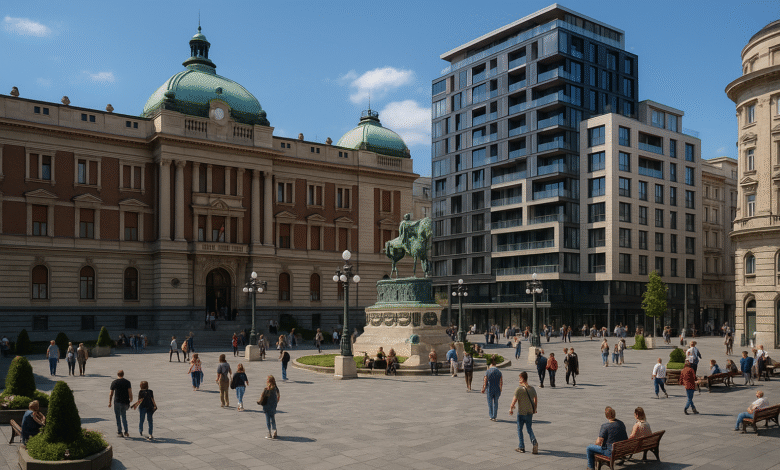маријин трг: The Beating Heart of Belgrade’s Urban Soul

Belgrade, the capital city of Serbia, is a dynamic blend of history, culture, and urban innovation. At the center of this bustling metropolis lies маријин трг, a square that captures the very essence of Belgrade’s transformation over the centuries. Far from being a mere geographic location, маријин трг is a place where the city’s past, present, and future meet. It serves as a hub of historical significance, architectural beauty, and cultural vitality.
What is маријин трг?
маријин трг, often referred to as Mariyin Trg or Marić Square, is located in the Savski Venac municipality, right at the heart of Belgrade. The square derives its name from the Marić family and holds a pivotal position in the city’s development. It functions as both a communal gathering place and a bridge between residential, commercial, and cultural districts.
The square has evolved through time, becoming one of Belgrade’s central points for traffic, tourism, and social engagement. Its geographical significance and its accessibility make it a key player in the city’s daily rhythm. It’s no surprise that маријин трг is also one of the most desirable areas for real estate, business development, and tourism in Serbia’s capital.
Historical Importance of маријин трг
The history of маријин трг traces back to the 19th century, during a crucial phase of modernization in Belgrade. As the city began to grow beyond its original borders, the need for a central urban point became evident. маријин трг emerged as that hub, connecting key roads and serving as a center for commercial activity and transit.
Its close proximity to major historic sites like the Kalemegdan Fortress, as well as its role in the city’s infrastructure planning, cemented its place in Belgrade’s urban evolution. Over time, this square became not just a location but a symbol of progress and connection in Serbian society.
Architectural and Urban Transformation
A walk through маријин трг reveals an extraordinary blend of old and new architecture. While many of its surrounding buildings preserve their original facades, the area has also welcomed modern high-rises, chic hotels, and commercial centers. This architectural diversity creates a visual narrative of Belgrade’s evolution.
Ongoing developments in the region, especially those tied to the Belgrade Waterfront Project, have reshaped маријин трг into a dynamic urban environment. Upscale residences, office spaces, and retail outlets now line the square, making it a prime example of successful urban planning. These changes also highlight Belgrade’s vision of merging tradition with innovation.
Cultural and Social Role
Beyond its structural appeal, маријин трг plays a vital role in the city’s cultural and social life. It serves as a venue for open-air concerts, art exhibitions, local markets, and various public events. Whether it’s a traditional Serbian music festival or a contemporary art showcase, the square is always alive with activity.
Its open layout and central location make it easily accessible for both locals and tourists, contributing to its popularity as a meeting point. Many consider маријин трг the cultural pulse of the city, where people from all walks of life come together to celebrate, protest, or simply relax.
маријин трг and the Belgrade Waterfront Project
One of the most ambitious urban revitalization efforts in Serbia, the Belgrade Waterfront Project, directly involves маријин трг. As the Sava Riverbank transforms into a modern district filled with residential towers, commercial spaces, and green parks, маријин трг has found itself at the center of this change.
With new infrastructure developments, enhanced transportation links, and increased tourism, the square is becoming more significant than ever. маријин трг now serves as a key gateway between the old charm of Belgrade and the futuristic vision the city is embracing.
Visiting маријин трг: What You Should Know
Whether you’re a local or a traveler, маријин трг offers something for everyone. Here’s what to explore:
-
Local Dining and Shopping: Discover cafes and restaurants that offer both traditional Serbian and modern cuisines. Shopping venues range from small artisan shops to modern boutiques.
-
Cultural Landmarks Nearby: Visit Kalemegdan Fortress, stroll along the Sava River, or explore nearby museums and galleries.
-
Events and Public Life: Depending on the season, you might experience live performances, food festivals, or holiday markets.
-
Street Art and Public Installations: маријин трг is dotted with sculptures and murals that reflect the creativity and resilience of Belgrade’s people.
Future Outlook: A Square for Generations
Looking ahead, маријин трг is expected to continue its rise as a vital component of Belgrade’s sustainable urban development. Plans include eco-friendly initiatives, improved pedestrian zones, and integration of smart city technologies. This ensures that the square will not only serve today’s population but also meet the needs of future generations.
As Belgrade continues to modernize, маријин трг will remain a living symbol of continuity and growth, blending history with high-tech aspirations.
FAQs About маријин трг
Where is маријин трг located in Belgrade?
It is situated in the central Savski Venac district, near the Sava River and close to major transportation and cultural landmarks.
What historical significance does маријин трг have?
The square has been a central point in Belgrade’s development since the 19th century and is linked to major phases of urban and cultural growth.
What are the major attractions near маријин трг?
Nearby attractions include Kalemegdan Fortress, the Belgrade Waterfront, and a variety of museums and parks.
Is маријин трг a good place to visit?
Absolutely. With its mix of shopping, dining, history, and public events, it offers something for every type of visitor.
What are the future plans for маријин трг?
As part of the Belgrade Waterfront Project, the square will continue to develop into a multifunctional urban hub, blending green spaces, commercial centers, and cultural venues.
Read also:Rowdy Oxford Integris: A Revolution in Ethical Innovation



